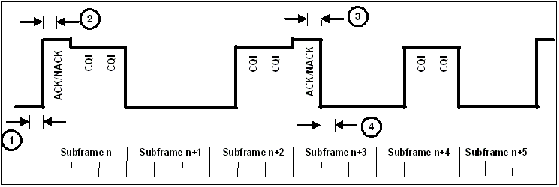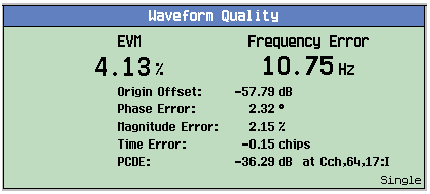How Do I Make a Waveform Quality Measurement?
- Measuring 3GPP TS 34.121 5.3 Frequency Error
- Measuring 3GPP TS 34.121 v7.5.0 s5.13.1A Error Vector Magnitude (EVM) with HS-DPCCH ( lab application or feature-licensed test application only )
Before performing these procedures, ensure that you have specified the proper Amplitude Offset for your test setup, and that the test set has been properly calibrated (see Calibrating the Test Set ).
Measuring 3GPP TS 34.121 5.3 Frequency Error
-
Set the downlink and uplink channels:
-
Set
Operating Mode( F1 ) toCell Off. -
Set
DL Channel( F10 ) andUplink Channel( F11 ) to the appropriate "low range" frequencies for your UE's operating band, as specified by 3GPP TS 34.108 5.1.1 (for example, for operating band I,DL Channel=10563andUplink Channel=9613). -
Set
Operating ModetoActive Cell.
-
Set
-
Establish an
RB Test Modeconnection between the UE and test set (see How Do I Set Up a Call and Make a Connection? ). -
Ensure that the
Connected DL Channel Levelsare set to their default values, as required by 3GPP TS 34.121 Tables 5.3 and E.3.1 (selectGenerator Info, F3 onCall Control 2 of 5). -
Set
Cell Power( F7 ) to-106.7 dBm. -
Set
UE Target Power:-
Ensure that
UL CL Power Ctrl Modeis set to its default value ofActive Bits(selectUL CL Power Ctrl Parameters, F8 on theCall Parms 3 of 3menu). -
Set
UE Target Power( F7 ) to the specified maximum output power for your UE (for example, 21 dBm for power class 4).
The test set then drives the UE to the specified level, while also appropriately ranging its measurement receiver.
-
Ensure that
-
Return to the
UL CL Power Ctrl Parametersmenu ( F8 ) and setUL CL Power Ctrl ModetoAll Up bitsand ensure thatUL CL Power Ctrl Algorithmis set toTwo. The test set then drives the UE to transmit at the highest level possible. - Press the Measurement selection key.
-
Select
Waveform Quality. -
Select
Waveform Quality Setup(F1) and setTrigger ArmtoSingle. - Press the START SINGLE key to begin the measurement.
-
Verify that the measured
Frequency Erroris less than +/- (0.1 ppm + 10 Hz). For an uplink frequency of 1922.6 MHz, this corresponds to a frequency error requirement of +/- 202.26 Hz.
- Repeat the test for "mid range" and "high range" frequencies (perform a Physical Channel Reconfiguration (Inter-frequency Hard Handover) , then repeat steps 12 and 13).
Measuring 3GPP TS 34.121 v7.5.0 s5.13.1A Error Vector Magnitude (EVM) with HS-DPCCH
This section is applicable to the lab application or feature-licensed test application only.
This test is applicable to Release 5 UEs only. For Release 6 and later UEs, see Measuring 3GPP TS 34.121 v7.5.0 5.13.1AA Error Vector Magnitude (EVM) and Phase Discontinuity with HS-DPCCH .
Overview:
3GPP TS 34.121 5.13.1A measures EVM at four locations on a defined 12 ms UE power pattern:

The test is performed such that the 12 ms UE power pattern maximum corresponds to the UE's maximum output power as defined in 34.121 Table 5.2A.2. The test is also performed such that the 12 ms UE power pattern maximum corresponds to -18 dBm.
Procedure:
-
Set parameters that can only be set in cell off operating mode (and other parameters that are set from the same menu):
-
Set
Operating Mode( F1 ) toCell Off. -
Select
34.121 Preset Call Configurations( F11 onCall Parms 1 of 3) and select5.2C, 5.7A, 5.13.1A, 5.13.1AA, 5.13.2A with QPSK. You may then skip any steps marked with [34.121 Call Config] in this procedure. -
Select
Channel (UARFCN) Parms( F12 onCall Parms 1 of 3). SetDL Channel( F7 ) andUplink Channel( F8 ) to the appropriate "low range" frequencies for your UE's operating band, as specified by 3GPP TS 34.108 5.1.1 (for example, for operating band II, setDL Channel=9663). -
[34.121 Call Config]
Select
Uplink Parameters( F4 onCall Control 2 of 5).-
[34.121 Call Config]
Set
Uplink DPCH Bc/Bd ControltoManual. -
[34.121 Call Config]
Set
Manual Uplink DPCH Bcto15(for 34.121 v7.2.0 Table C.10.1.4 sub-test 3). -
[34.121 Call Config]
Set
Manual Uplink DPCH Bdto8(for 34.121 v7.2.0 Table C.10.1.4 sub-test 3). -
[34.121 Call Config]
Set
Maximum Uplink Transmit Power Levelto+21 dBm.
-
[34.121 Call Config]
Set
-
Set
Operating ModetoActive Cell(pressing the CALL SETUP key quickly brings you back to the top levelCall Controlmenu).
-
Set
-
[34.121 Call Config]
Set
Channel Type( F8 ) to12.2k RMC + HSDPA. -
Select
HSDPA Parameters(HSPA Parameters( F10 ), F10 ).-
Select
HSDPA RB Test Mode Setup( F8 ).-
[34.121 Call Config]
Set
HS-DSCH Configuration TypetoFRC(this is the default value). -
[34.121 Call Config]
Set
FRC TypetoH-Set 1 QPSK(this is the default value). -
Set
CN Domainas needed (by default it is set toPS Domain). Note, before you can establish a connection in the PS domain, the UE must attach to the test set. To enable this, thePS Domain Informationparameter (underCell Parameters, F12 onCall Control 2 of 5) must be set toPresentwhen the UE registers (attaches) with the test set.
-
[34.121 Call Config]
Set
-
[34.121 Call Config]
Select
HSDPA Uplink Parameters( F11 ).-
[34.121 Call Config]
Set
DeltaACKandDeltaNACKto8. -
[34.121 Call Config]
Set
DeltaCQIto7. -
[34.121 Call Config]
Set
Ack-Nack Repetition Factorto1(this is the default value). -
[34.121 Call Config]
Set
CQI Feedback Cycle (k)to4 ms. -
[34.121 Call Config]
Set
CQI Repetition Factorto1(this is the default value).
-
[34.121 Call Config]
Set
-
Select
-
Test Application: Select
Cell Parameters( F2 ).
Lab Application: SelectCell Info ( F2 ), thenCell Parameters( F2 ).
(from theCall Control 2 of 5menu)-
[34.121 Call Config]
Set
Default DPCH Offset (DOFF)to3 x 512 chips. -
Set
PS Domain InformationtoPresent(this is the default value in the lab application) if you plan to establish the HSDPA connection in the PS domain (i.e. if you've setCN DomaintoPS DomainorCS/PS Domainin step 3 above). -
Qqualmin and Qrxlevmin are fixed to -24 dB and -115 dBm, respectively, in the test application. In the lab application these are the default values for these parameters. They are accessible from
Cell Info,Reselection Parameters( F3 ).
-
[34.121 Call Config]
Set
-
[34.121 Call Config]
Select
Generator Info( F3 onCall Control 2 of 5), selectConnected DL Channel Levels( F4 ), then selectHSDPA Conn DL Channel Levels( F4 ).-
[34.121 Call Config]
Set
Cell 1 Connected HSDPA CPICH Levelto-10 dB(this is the default value). -
[34.121 Call Config]
Set
Cell 1 Connected HSDPA P-CCPCH/SCH Levelto-12 dB(this is the default value). -
[34.121 Call Config]
Set
Cell 1 Connected HSDPA PICH Levelto-15 dB(this is the default value). -
[34.121 Call Config]
Set
Cell 1 Connected HSDPA DPCH Levelto-9 dB. -
[34.121 Call Config]
Set
Cell 1 Sum of Active Conn HS-PDSCH Levelsto-3 dB(this is the default value). -
[34.121 Call Config]
Set
Cell 1 Connected HS-SCCH 1 Levelto-8 dB.
-
[34.121 Call Config]
Set
- Set any other parameters needed to establish a connection with your UE, then power on the UE and wait for it to register (attach). See Establishing an HSDPA Connection .
-
Select
Originate Call( F3 onCall Control 1 of 5). -
Set
Cell Power( F7 onCall Parms 1 of 3) to-86 dBm/3.84 MHz. -
Select
UL CL Power Ctrl Parameters( F8 onCall Parms 3 of 3). -
To perform the test such that the 12 ms UE power pattern maximum corresponds to the UE's maximum output power as defined in 34.121 Table 5.2A.1, set
UE Target Power( F7 onCall Parms 3 of 3) to the appropriate value for your UE's power class.Required UE Target Power Setting to Achieve Table 34.121 Table 5.2A.2 Maximum Power UE Power Class 34.121 v7.5.0 Table C.10.1.4 Sub-Test UE Target Power setting 3 3 16.9 dBm 4 3 13.9 dBm For example, for a power class 3 UE, set
UE Target Powerto16.9 dBm(the test set rounds this value to 17 dBm). The test set drives the UE's DPCCH+DPDCH level to 17 dBm, which places the UE's DPCCH+DPDCH+HS-DPCCH level at 23.1 dBm, while also appropriately ranging the test set's measurement receiver. -
Select
UL CL Power Ctrl Parameters( F8 onCall Parms 3 of 3). SetUL CL Power Ctrl ModetoAlternating bits. -
You can you use the
Dynamic Power Analysismeasurement to quickly verify that your UE is transmitting the 12 ms power pattern specified by 5.13.1A. To do so, press the Measurement selection key and selectDynamic Power Analysis, then selectDynamic Power Setup( F1 ) and select34.121 5.7A Measurement Configuration, thenYes(or setStepsto37,Step Lengthto333.3 us,Measurement Intervalto283.3 us,Trigger SourcetoHS-DPCCH,Trigger Delayto-308.3 us, andHS-DPCCH Trigger Subframe Alignmenttosubframe 0). Press START SINGLE and adjust theAxis Control( F2 ) as needed.
Once you have verified that your UE is transmitting the proper pattern, you can initiate the Waveform Quality measurement and adjust the Waveform Quality trigger settings to measure each test point:
- Press the Measurement selection key.
-
Select
Waveform Quality. -
Set up the Waveform Quality measurement:
-
Select
Waveform Quality Setup( F1 ). -
To measure test point 1, select
34.121 5.13.1A Low of Low-High Transition, then selectYes. You may then skip any steps marked with [34.121 Meas Config] . -
[34.121 Meas Config]
Set
Trigger SourcetoHS-DPCCH. -
[34.121 Meas Config]
Set
Transient PeriodtoExclude. -
[34.121 Meas Config]
Set HS-DPCCH Measurement Interval to
0.5 slot. -
Set
Trigger ArmtoSingle, if desired. -
Select
Close Menu( F6 ).
-
Select
-
If you set
Trigger ArmtoSingle, press the START SINGLE key to begin the measurement.
-
Verify that the measured EVM is less than 17.5% for each of the four test points, using the following settings:
Waveform Quality Settings for the Four Test Points These settings are automatically set by the 34.121 Meas Configs HS-DPCCH Trigger Subframe Alignment HS-DPCCH Trigger Slot Alignment HS-DPCCH Trigger Subslot Alignment 1 subframe 5 CQI2 0.5 slot 2 subframe 0 AckNack 0.0 slot 3 subframe 3 AckNack 0.5 slot 4 subframe 3 CQI1 0.0 slot -
To perform the test such that the 12 ms UE power pattern minimum corresponds to -18 dBm:
-
Select
UL CL Power Ctrl Parameters( F8 onCall Parms 3 of 3). SetUL CL Power Ctrl ModetoActive bits. -
Set
UE Target Power( F7 onCall Parms 3 of 3) to-24.1 dBm(for 34.121 v7.2.0 Table C.10.1.4 sub-test 3). The test set drives the UE's DPCCH+DPDCH level to -24 dBm, which places the UE's DPCCH+DPDCH+HS-DPCCH level at approximately -18 dBm, while also appropriately ranging the test set's measurement receiver. -
Select
UL CL Power Ctrl Parameters( F8 onCall Parms 3 of 3). SetUL CL Power Ctrl ModetoAlternating bits. - Repeat steps 12-17.
-
Select
-
To perform the test for "mid range" and "high range" frequencies:
- Perform a Physical Channel Reconfiguration (Inter-frequency Hard Handover) to the appropriate UARFCNs.
- Repeat steps 9-18.
Related Topics
Waveform Quality Measurement Description
Waveform Quality Troubleshooting
Programming a Waveform Quality Measurement
How Do I Make a Dynamic Power Analysis Measurement?
Measuring 3GPP TS 34.121 v7.5.0 5.13.1AA Error Vector Magnitude (EVM) and Phase Discontinuity with HS-DPCCH (using the Phase Discontinuity measurement)